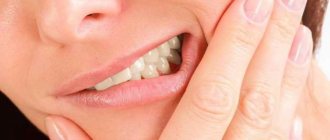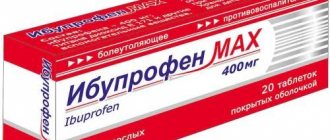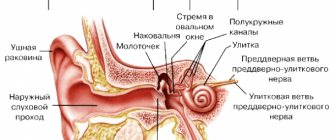Chronic purulent mesotympanitis
Mostly in people, purulent otitis media takes the form of a permanent disease. During otoscopy, the part of the membrane that is not stretched remains untouched; perforation will be observed in the stretched part of the membrane. The symptoms of the disease can be mild, so it can be difficult to diagnose at the initial stage. Patients often experience constant or periodic rotting of the ear, as a result of which the quality of hearing decreases. A clearly noticeable sharp pain in the ear signals that the disease process has worsened.
Purulent ear discharge does not have a specific or pronounced odor, so the pus can persist for months or even years. All this can contribute to serious complications.
There are certain factors that cause exacerbations of purulent otitis media:
- diseases of the pharynx;
- problems with the paranasal sinuses and their inflammation;
- moisture entering the ear;
- severe swelling of the upper respiratory tract.
The first symptom of mesotympanitis is a small, barely noticeable painful impulse in the ear. With proper treatment of the disease, instead of a hole in the ear, a scar will appear, it looks like a light film. Mesotympanitis is not characterized by roughness, which means that there will be no caries.
Chronic purulent otitis media
Chronic suppurative otitis media is characterized by constant or periodically appearing suppuration, decreased hearing and perforation of the eardrum. There are two main forms - epitympanitis and mesotympanitis. Mesotympanitis is characterized by damage to the mucous membrane of the middle part of the tympanic cavity with purulent (or mucopurulent) odorless discharge from the ear. Central (not reaching the bone ring) perforation of the tympanic membrane is typical. Sometimes granulations and polyps are visible. Epitympanitis is characterized by damage not only to the mucous membrane, but also to the bone, spreading even to the mastoid process. Often there is cholesteatoma (pseudocholesteatoma) of the ear. It is formed as a result of the ingrowth of the epidermis of the external auditory canal or tympanic membrane into the middle ear. When growing into the middle ear, the epidermis loses its integumentary properties. As a result of the desquamation of its cells, a tumor-like formation is formed, which, as it grows, destroys the surrounding tissue, which contributes to the development of various complications. Epitympanitis is characterized by purulent discharge with a pungent odor, marginal perforation reaching the bone rim. It is often localized in the shrapnel part of the membrane.
Treatment : elimination of all pathological changes in the nose, its paranasal sinuses, and nasopharynx. For mesotympanitis, conservative treatment is usually carried out - systematic toileting of the ear, instillation of a 3% solution of boric alcohol, injection of the finest boric acid powder, sulfonamides. The main conservative treatment method for epitympanitis is rinsing with alcohol solutions using a special cannula (done by a doctor). In the absence of effect from conservative treatment and complications, radical (whole cavity) ear surgery is performed. The purpose of the operation is to create a common cavity consisting of the external auditory canal, tympanic cavity, cave and areas of the mastoid process affected by the pathological process.
Complications of chronic purulent otitis media: paresis and paralysis of the facial nerve, meningitis, otogenic sepsis, brain abscess, arachnoiditis, extradural and subdural abscess.
Chronic non-suppurative otitis media (chronic catarrh of the middle ear, adhesive otitis, dry perforated otitis, tympanosclerosis) is a group of diseases, the exact differentiation between which is still a controversial issue. The main complaint is decreased hearing, often severe hearing loss. Otoscopy reveals a pronounced retraction of the eardrum, in some cases cicatricial changes, sometimes partial calcification, dry perforation. Treatment : systematic ear blowing, pneumomassage of the eardrum, physiotherapeutic measures.
If there is no effect, tympanoplasty is performed (see).
Internal otitis - see Labyrinthitis.
Rice. 12. Chronic purulent otitis media; perforation in the anterioinferior quadrant of the eardrum.
Chronic purulent otitis media (otitis media purulenta chronica). The reasons for the transition of acute otitis to chronic are; large destruction in the tympanic cavity; inflammatory changes in the nose and nasopharynx, adenoid growths; improper treatment in the acute stage of otitis.
Course and symptoms. According to the clinical course, benign and non-benign chronic purulent otitis media are distinguished - meso- and epitympanitis. With mesotympanitis, the process does not extend beyond the mucous membrane; the perforation of the eardrum does not reach the bone ring - central perforation (tsvetn. fig. 12). With epitympanitis, the bone walls of the cavity are usually also involved in the process, the perforation extends to the bone ring (marginal perforation) or is located in the shrapnel part. With mesotympanitis, the mucous membrane is hyperemic and thickened; discharge from the ear is usually mucopurulent in nature. There is often copious mucous discharge, which also indicates inflammation of the auditory tube (tubo-otitis). Hearing loss with mesotympanitis usually does not reach a sharp degree. With exacerbation of mesotympanitis, the amount of purulent discharge increases and the temperature rises. In its course, exacerbation of mesotympanitis resembles acute otitis media.
With epitympanitis, there are often granulations in the form of reddish protrusions, or polyps, caries. Purulent discharge is usually scanty and odorous. A complication of epitympanitis is cholesteatoma, which is formed as a result of ingrowth of the epidermis from the external auditory canal through the marginal perforation into the epitympanic space. Under the influence of irritation by pus, the epidermis begins to grow, and then swells and dies. Layers of dying epidermis layering on top of each other lead to the growth of cholesteatoma, which fills the epitympanic space and cave. As it grows further, the surrounding bone is destroyed. Destruction of the bone wall of the horizontal semicircular canal and the formation of a fistula are often accompanied by nystagmus and dizziness when pressing on the tragus. When the fallopian canal is destroyed, paresis or paralysis of the facial nerve occurs. With exacerbation of epitympanitis and suppuration of cholesteatoma, abundant foul-smelling purulent discharge appears, the general condition of the patient worsens, and sometimes symptoms of intracranial complications may appear (sinus thrombosis, sepsis, meningitis, brain abscess). Hearing with epitympanitis is usually sharply reduced.
Diagnosis. Differentiation between epitympanitis and mesotympanitis can sometimes be difficult. Diagnostics is aided by probing the perforation with a specially curved button probe. With marginal perforations, the probe freely falls into the supratympanic space. In the presence of a carious process, a probe can probe the exposed bone, and in case of cholesteatoma, crumbly masses of the epidermis can be detected. To diagnose cholesteatoma, sometimes the epitympanic space is washed with a special cannula and an x-ray of the ear is taken.
Treatment. Rinse the ear with disinfectant solutions, pour in drops (hydrogen peroxide, alcohol with hydrogen peroxide, boric alcohol). Injection of a solution of penicillin and streptomycin into the middle ear under pressure has been successfully used. Large granulations and polyps are removed surgically. For cholesteatoma, systematic rinsing of the epitympanic space with slightly warmed alcohol is prescribed. Epitympanitis is often difficult to treat conservatively. In some cases, cure can only be achieved by radical, or whole-cavity, ear surgery. The operation is indicated if, after systematic treatment, the suppuration remains profuse, the odor is foul, and the removed polyps form again (in this case, there are frequent complaints of headache, periodic dizziness, and nausea). Indications for surgery are also exacerbation of chronic otitis with mastoiditis with subperiosteal abscess and the appearance of facial nerve paresis. The appearance of signs of intracranial complications requires urgent surgery.
Radical, or general cavity, surgery is usually performed using the extra-auricular method, but it can also be done intra-ear - through the external auditory canal. With the extra-auricular method, an incision behind the ear and separation of soft tissues is performed in the same way as during surgery for mastoiditis. After this, with a thin rasp, the skin of the posterior and upper bone wall of the ear canal is peeled off up to the eardrum and the posterior bone wall of the ear canal and a small section of the bone wall - the bridge hanging over the aditus ad antrum - are removed (this moment of the operation is very important due to the risk of injury to the facial nerve and horizontal semicircular canal). Then the granulations and carious malleus and incus are removed. To ensure wide communication with the external auditory canal and epidermization of the bone walls of the newly created cavity, plastic surgery of the auditory canal is performed. The posterior skin wall is cut in the middle along its entire length - from the free end to the auricle, where a second incision is made perpendicular to the first one up and down. The two triangular flaps obtained in this way are applied to the walls of the operating cavity and fixed with a suture or tampons. After epidermization of the cavity, suppuration stops. In the future, periodic monitoring of the cavity is required, since epidermal masses often accumulate in it, affecting the delicate layer of newly formed skin and again causing suppuration from the ear. For certain indications, radical intra-auricular surgery is performed. Its advantages are that the path to the pathological focus is much shorter and, therefore, it is not necessary to remove a lot of healthy bone. This simplifies postoperative treatment and shortens its duration. However, from a technical point of view, this operation is more complex than the extra-auricular one.
A variant of radical surgery is the so-called conservative radical surgery, or attico-antrotomy, in which only the antrum and attic are opened, and the eardrum and auditory ossicles are preserved. This operation can be used only with limited damage to the attic and antrum (with cholesteatoma of this area).
A fundamentally new operation is tympanoplasty (see), which aims not only to remove the pathological focus and stop the flow of suppuration, but also to improve hearing.
Prevention. The best measure is complete cure of acute otitis media. To prevent infection of the middle ear through the external auditory canal, patients with persistent perforation of the eardrum should cover their ears with cotton wool moistened with petroleum jelly or other oil when bathing and washing their hair. A hole caused by a perforation of the eardrum can be repaired by carefully cauterizing its edges with trichloroacetic acid or by plastic surgery.
Diagnosis of the disease
All diagnostics are based on the obtained anamnesis data. Persistent, unsightly perforation of the eardrum is one of the hallmarks of the disease. The pus should have no odor; if the odor is still present, this indicates a carious process in the bone. In this case, there is a high probability of the disease transitioning to a substandard state and worsening the disease process.
It is quite easy to distinguish mesotympanitis from epitympanitis:
- odorless discharge of pus;
- there is a central preformation;
- the absence of any damage to the bone tissue can be shown by an x-ray of the temporal areas of the bone
Symptoms of mesotympanitis
The main symptom of mesotympanitis is deterioration of hearing from the ear with the damaged membrane and intoxication of the body, manifested by weakness, headache, drowsiness, and temperature up to 39°C. There is a pulsation in the ear area.
An exacerbation of the disease is indicated by discharge that appears from the ear, which can have a different character: first in the form of odorless mucus, then in the form of pus with an unpleasant odor. If the process affects only the middle ear, low-frequency noise, congestion, and reflection of one’s own voice appear in it.
With repeated episodes of mesotympanitis and damage to the inner ear, high-frequency ringing, whistling, squeaking and further hearing loss occur. Even with moderate physical activity and slight turns of the head, vestibular disorders in the form of dizziness can occur.
The causes of mesotympanitis are previous acute respiratory viral infections, hypothermia and water getting into the ear.
Treatment of mesotympanitis
A doctor can prescribe surgical treatment only if there are serious abnormalities in the functioning of the respiratory tract. In this case, the patient needs urgent rehabilitation. To prevent the ear, you should wash it with various solutions every day. An antiseptic solution will do an excellent job of this.
After the ear has been washed with the solution, it should be thoroughly dried, and it would also be a good idea to powder it with boron powder. X-rays of the temporal bones will help to investigate chronic purulent mesotympanitis; it makes it possible to evaluate the cellular system of the appendix much more thoroughly. In the chronological state of the disease, the patient will have a sclerotic structure of the temporal bone.
Diagnostics
Effective treatment of epitympanitis requires its timely diagnosis. It includes the following studies:
- otomicroscopy, which helps identify defects in the membrane, destruction of the bone wall of the cavity, deformation of the elements of the middle ear;
- endoscopic examination with functional tests to determine the condition of the mouths of the auditory tubes and their patency;
- endoscopy of the nasopharynx to detect factors contributing to the long-term course of the disease;
- hearing testing and audiometry;
- otoneurological examination with concomitant damage to the labyrinth;
- computed tomography of the temporal bones to determine the degree of destruction of bone tissue;
- bacteriological examination of ear discharge to identify pathogens and effective antibiotics; epitympanitis is characterized by anaerobic microorganisms;
- clinical blood tests, urine tests, and other studies to determine the general state of health and the influence of the chronic purulent process in the middle ear on it.
If a patient develops complications of epitympanitis, he needs consultation with a neurologist, ophthalmologist, neurosurgeon and an MRI of the brain.
Prevention
To prevent the development of mesotympanitis, the following preventive measures should be applied in practice:
- timely treatment of inflammatory diseases of the nasopharynx;
- proper, regular ear hygiene;
- proper, nutritious nutrition;
- maintaining a healthy lifestyle;
- correction of anatomical disorders of the ear canals, if any;
- strengthening the immune system.
If foreign objects get into the ear or if the above symptoms are present, you should contact an otolaryngologist, and not carry out treatment at your own discretion. In addition, you need to systematically undergo a preventive examination by an otolaryngologist. Preventing a disease is much easier than treating it and eliminating complications.
What to do?
If you think you have Mesotympanitis
and symptoms characteristic of this disease, then an otolaryngologist can help you.
Source
Did you like the article? Share with friends on social networks:
Causes of mesotympanitis
The main reason for the development of mesotympanitis is the transition of acute exudative otitis media to a chronic form. In this case, the composition of the bacterial microflora changes somewhat compared to the acute process; the presence of several pathogens is often determined at the same time. These are mainly aerobes Pseudomonas aeruginosa and Staphylococcus aureus, which are found in 50-85% of patients. Less commonly, anaerobic flora is detected, represented by gram-positive cocci (Peptococcus and Peptostreptococcus), Bacteroides or gram-negative Klebsiella and Proteus. Fungi of the genus Aspergillus and Candida are detected in 2-15% of patients.
Factors that contribute to chronic inflammation of the tympanic cavity and the development of mesotympanitis are identified. These include:
- Diseases of the nasal cavity and nasopharynx
. This group of pathologies includes tumors, proliferation of adenoid vegetations, deformations of the nasal septum and other conditions that impair the drainage function of the auditory tube, preventing the outflow of purulent masses from the tympanic cavity. - Anomalies of the structure of the maxillofacial region
. The list includes choanal atresia, Down syndrome, cleft lip, and other defects that deform or block the lumen of the eustachian tube. - Associated pathologies
. This primarily concerns diabetes mellitus, which reduces local tissue resistance and promotes high activity of pathogenic microflora. - Immunodeficiency conditions
. The absence of a systemic immune response ensures uncontrolled proliferation of flora, rapid formation of complications, and generalization of infection. These conditions include the last stages of cancer development, oncohematological pathologies, and AIDS. - Inadequate treatment of acute otitis media
. Incorrectly selected antibacterial drugs, non-compliance with the dose or an incomplete course of antibiotic therapy contributes not only to the transition of an acute disease to CGSO, but also to microflora resistance to drugs.
Mechanism and causes of the disease
Penetrating into the tympanic cavity, microbes begin to actively multiply in its membranes, mainly affecting the mucous membrane of the Eustachian tube, its underlying sections, the auditory ossicles and the eardrum. Because of this, the functions, drainage and natural ventilation of the hearing organ are disrupted.
The causative agents of the disease are:
- streptococci and staphylococci;
- Pseudomonas aeruginosa and Hemophilus influenzae;
- fungi.
Often, several types of microorganisms are sown in smears at once.
Predisposing factors that provoke the disease include:
- acute and chronic inflammation of the ear (otitis) or pathology in the eustachian tube (eustachitis), lesions of the labyrinth;
- persistent infectious processes in the nasopharynx and throat (rhinitis, sinusitis, tonsillitis, retropharyngeal abscesses) or in the oral cavity (glossitis, stomatitis, periodontal disease, gingivitis, caries, dental cysts);
- anatomical defects in the structure of the facial bones, nose, pharynx, ears;
- foreign objects getting into the ears (cotton wool, insects, hair);
- perforation of the eardrum during ear cleaning or medical procedures;
- wounds, bruises of the ear;
- getting contaminated water into the ears when swimming in public places;
- high sensitivity of people to certain bacteria;
- depletion of the body's biological resources, decreased immune status (after viral infections, surgical interventions, chemotherapy);
- ear tumors;
- lymphadenitis;
- general infections: measles, scarlet fever, mumps, etc.;
- systematic hypothermia;
- neglect of hygiene of ears, nose, teeth;
- diseases of the skeletal system (osteomyelitis);
- injuries to the face and skull.
Complications
All complications arising from mesotympanitis are usually divided into two main groups: intracranial and extracranial. The first include meningitis, encephalitis, brain abscesses, etc. Their development is caused by the destruction of the upper wall of the tympanic cavity with the subsequent spread of bacterial flora and purulent masses directly to the meninges. The group of extracranial complications includes subperiosteal abscess, mastoiditis, labyrinthitis, and facial nerve paresis. The mechanism of their development is also based on purulent melting of the walls of the middle ear, but with the involvement of the orbit, mastoid process, and structures that form the facial nerve canal or labyrinth in the pathological process. In the latter case, profound sensorineural hearing loss often occurs in parallel. Against the background of immunodeficiency states, there is a high risk of generalization of infection and the development of otogenic sepsis.
Prognosis and prevention
The prognosis for mesotympanitis is relatively favorable. If therapy is started in a timely manner, it is possible to restore hearing to its original level and avoid the development of septic complications and sensorineural hearing loss. With intracranial spread of purulent masses, the outcome depends on the results of treatment of complications. Prevention of mesotympanitis involves complete rational treatment of the acute form of purulent otitis media, strengthening the body’s general defenses, timely normalization of the eustachian tube, removal of adenoid vegetations, and correction of other predisposing factors.
Symptoms of the disease
Symptoms of mesotympanitis
The clinical picture of mesotympanitis manifests itself as follows:
- hearing impairment;
- sharp and intense pain during the period of exacerbation, aching and short-lived in nature during the period of remission;
- sensation of pulsation in the area of the sore ear;
- noise in ears;
- discharge of purulent exudate;
- increased body temperature, which is caused by the inflammatory process;
- inflammation of the submandibular and cervical lymph nodes;
- signs of general intoxication of the body;
- sleep disturbance caused by pain in the affected ear;
- irritability, sudden mood swings.
During a physical examination of the patient, the presence of this disease may be indicated by the following:
- the external passage in the ear is filled with purulent exudate, sometimes mixed with blood;
- perforation is observed along the edge or in the center of the eardrum;
- hyperemia and swelling of the mucous membrane;
- fine granulation.
It should be noted that hearing loss is a symptom that does not appear immediately. Deterioration in auditory perception is observed when the auditory ossicles become impregnated with pus.
With such a clinical picture, you should urgently contact an otolaryngologist, and not attempt to eliminate the disease yourself. In this case, the development of serious complications can be avoided.
Treatment
Treatment regimens depend on the phase of the disease. Thus, if complications develop, immediate hospitalization of the patient is necessary; if there is an exacerbation, hospital treatment may be delayed. NIKIO invites patients with epitympanitis in remission to improve and restore the structures of the middle ear and normalize auditory function. If necessary, inpatient treatment is provided.
Treatment includes medications, physiotherapeutic methods and surgery.
Conservative therapy
In case of epitympanitis, it is used as preparation for surgery and in case of severe exacerbation of the disease:
- ear drops with antibacterial, anti-inflammatory or combined effects;
- injection of antiseptics and mucolytic agents into the middle ear cavity;
- physiotherapy: laser irradiation, electromyostimulation of the auditory tube, UHF, darsonvalization, magnetic therapy, electrophoresis and others.
Only drug treatment can be used only in patients with severe concomitant diseases or who refuse surgery.
Surgery
If acute complications develop, an urgent large-scale operation is performed - opening the middle ear cavity, removing part of the ear canal and the bone walls of the tympanic chamber. The most favorable period is within six months - 12 months after the end of the exacerbation.
Surgeons use different methods of surgery, selecting the optimal one for each patient. Such an intervention involves removal or cleansing of the purulent focus and restoration of the integrity of the eardrum (tympanoplasty). If cholesteatoma is present, it is removed.
The operation results in restoration or improvement of hearing in more than 90% of patients.
ethnoscience
Traditional recipes can only be used in addition to conventional treatment after consultation with a doctor, in the absence of an active inflammatory process:
- Boil 5 pieces of bay leaf in 200 ml of water, instill 10 drops into each ear daily;
- daily compresses with baked onion gruel or chopped plantain leaf;
- warming cotton compresses with alcohol on the behind-the-ear area;
- use of ultraviolet irradiation (“blue lamp”) at home.
Mesotympanitis
Mesotympanitis accounts for more than 50% of all forms of chronic suppurative otitis media (CSOM). The overall prevalence of the disease is from 2 to 35% of the world's population. In Russia, this pathology occurs with a frequency of 8.2 to 40.1 per 1,000 people. From 6 to 8% of patients who require hospitalization and treatment in a hospital setting suffer from CHSO. Mesotympanitis is considered a relatively favorable form of the disease, since it is not accompanied by severe destruction of bone structures. However, with a long course of the disease, more than 55% of patients develop caries of the auditory ossicles, and 20-23% develop lysis of the walls of the tympanic cavity. Mortality when complications occur ranges from 15-25%.
Diagnosis and treatment methods
Diagnosis of purulent mesotympanitis should be made at the first suspicion of any ear disease. Since the effect of the disease is directly reflected on the eardrum, its presence can be determined using a standard otoscopy procedure. A qualified otolaryngologist is able to make a diagnosis after a thorough examination of the patient and collection of anamnesis.
If the picture is unclear, additional research may be needed. The best way to demonstrate the current situation is by radiography and computed tomography. Thanks to x-rays in several projections, it is possible to identify the extent of damage to the bone tissue of the ear. CT, in turn, complements them and makes it possible to examine the source of inflammation and the extent of its spread.
Only after the doctor is sure of the correct diagnosis can active treatment begin. In this case, it is necessary to take into account the characteristics of the disease and the openness of access to the middle ear cavity.
For chronic mesotympanitis, treatment is long-term, and it must correspond to the observed phase of the disease. All approaches are divided into two main groups: conservative and radical. In the first case, medications and physical therapy are used, in the second, surgery is performed.
Conservative treatment begins with eliminating the source of infection. If there are diseases of the nasopharynx, it is necessary to first cure them, and only after that begin active intervention in the ear cavity. In parallel with the main therapy, you need to take a course of vitamins and antihistamines to reduce the risk of complications and strengthen the immune system.
Antibiotics are mandatory medications used to eliminate inflammation. In order for them to have the maximum effect, it is necessary to first clean the ear cavity from the accumulation of pus; for this, the organ is sanitized and purged. Boron powder is used for drying and disinfection. Ointments and suppositories, drops, aerosols, and, if necessary, oral antibiotic tablets are also used.
Microwave exposure, electrophoresis, phonophoresis, faradization and other methods of physiotherapy improve the results of therapy. They can be performed during remission to consolidate the result.
Over time, the eardrum begins to scar, and if the outcome is favorable, hearing is completely restored. However, therapeutic methods do not always demonstrate success. There is also a risk of the formation of connective growths that block the ear canal and the movement of the bones.
To solve a complicated situation, surgical treatment is used. This is mainly due to the formation of polyps on inflamed tissues or cords on the eardrum. The growths are removed using a loop and cauterized with special preparations. The integrity of the membrane itself is restored through myringoplasty.












